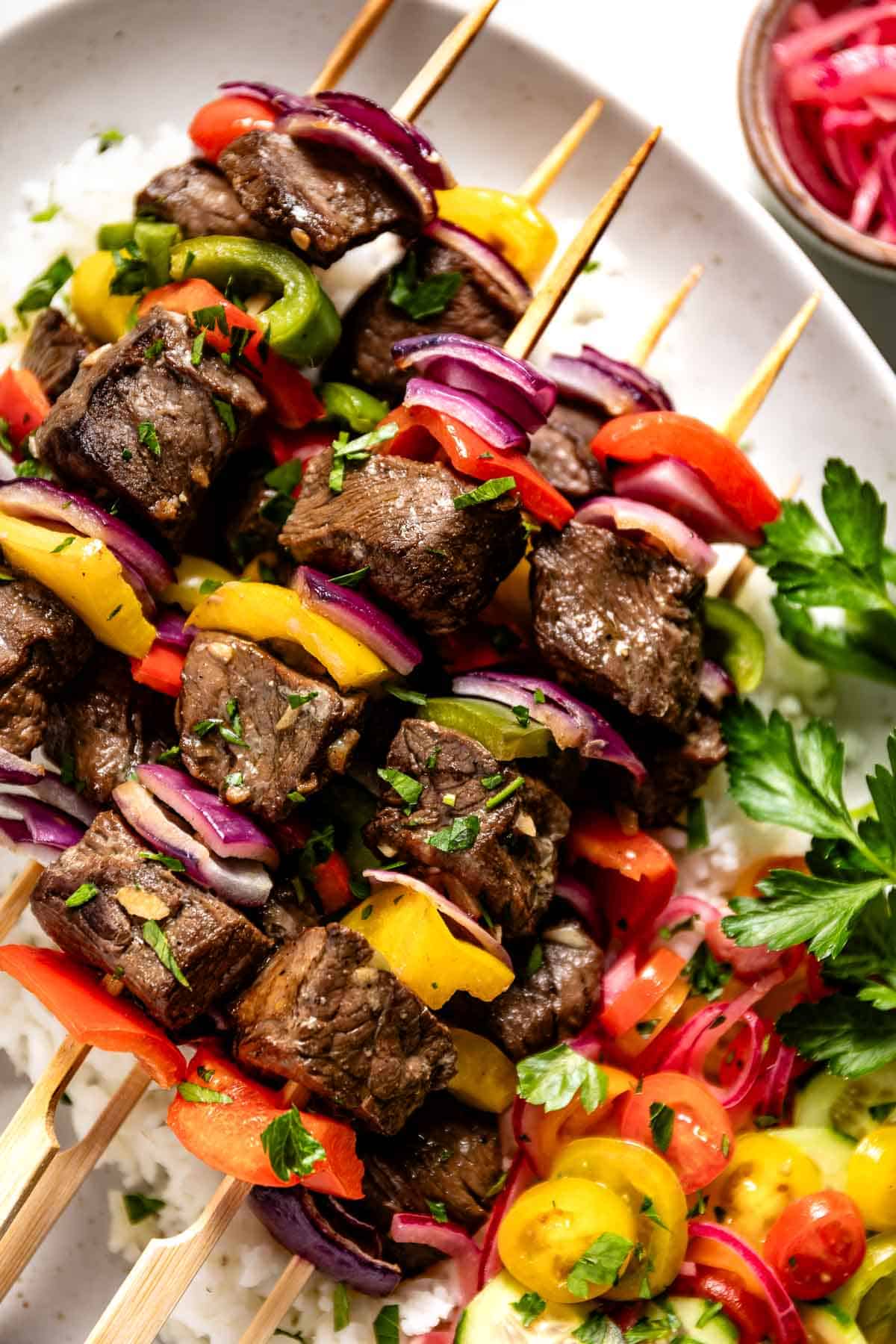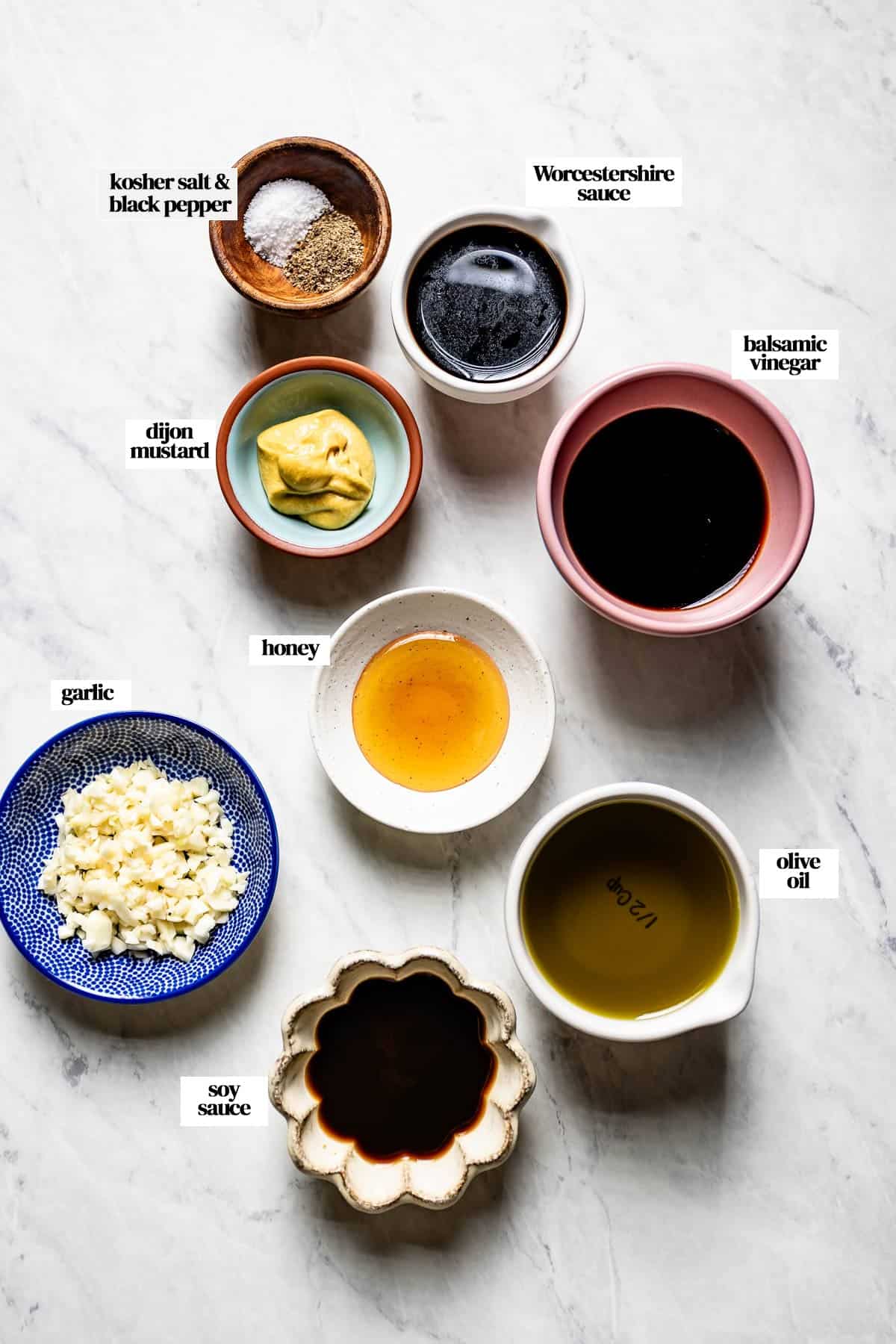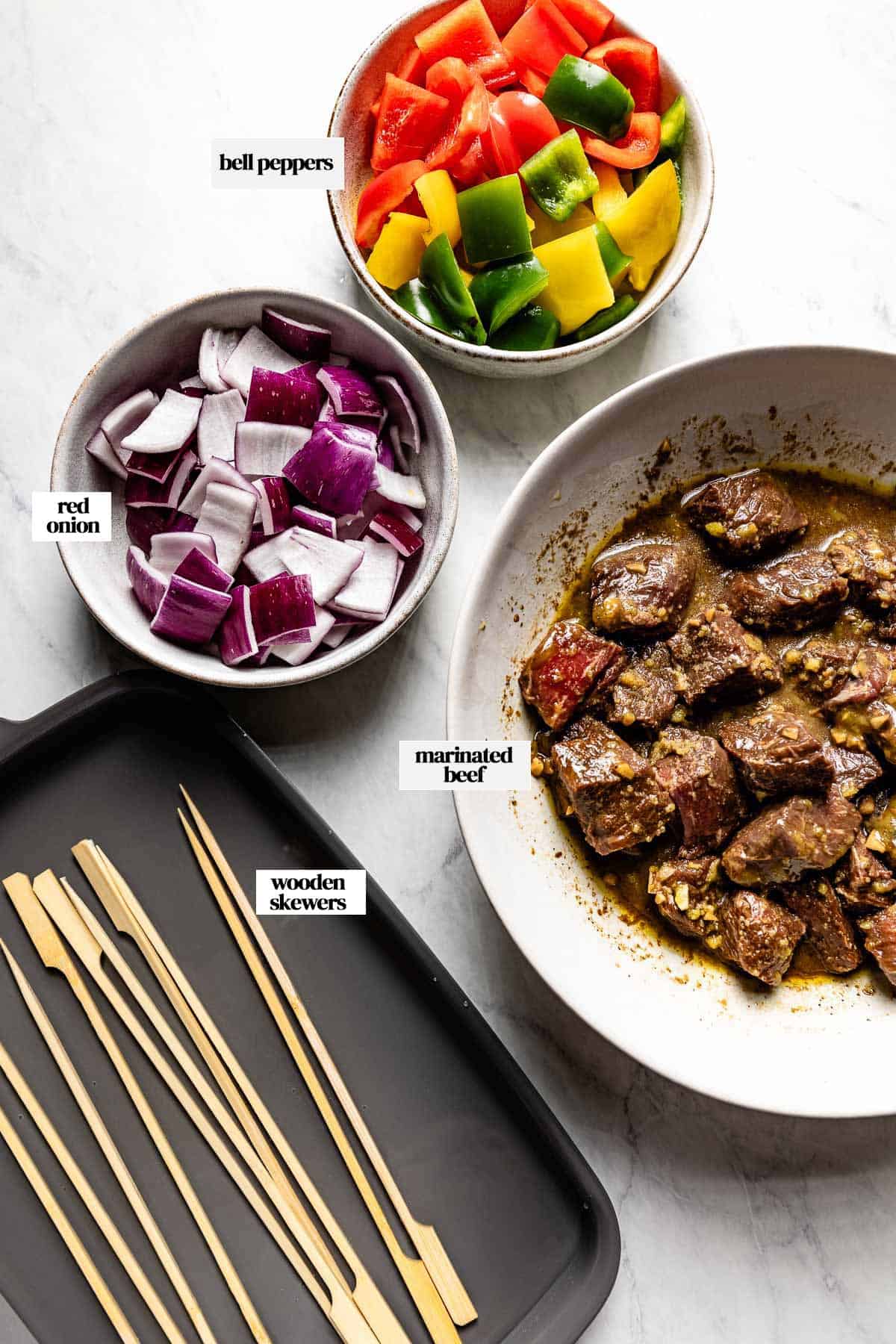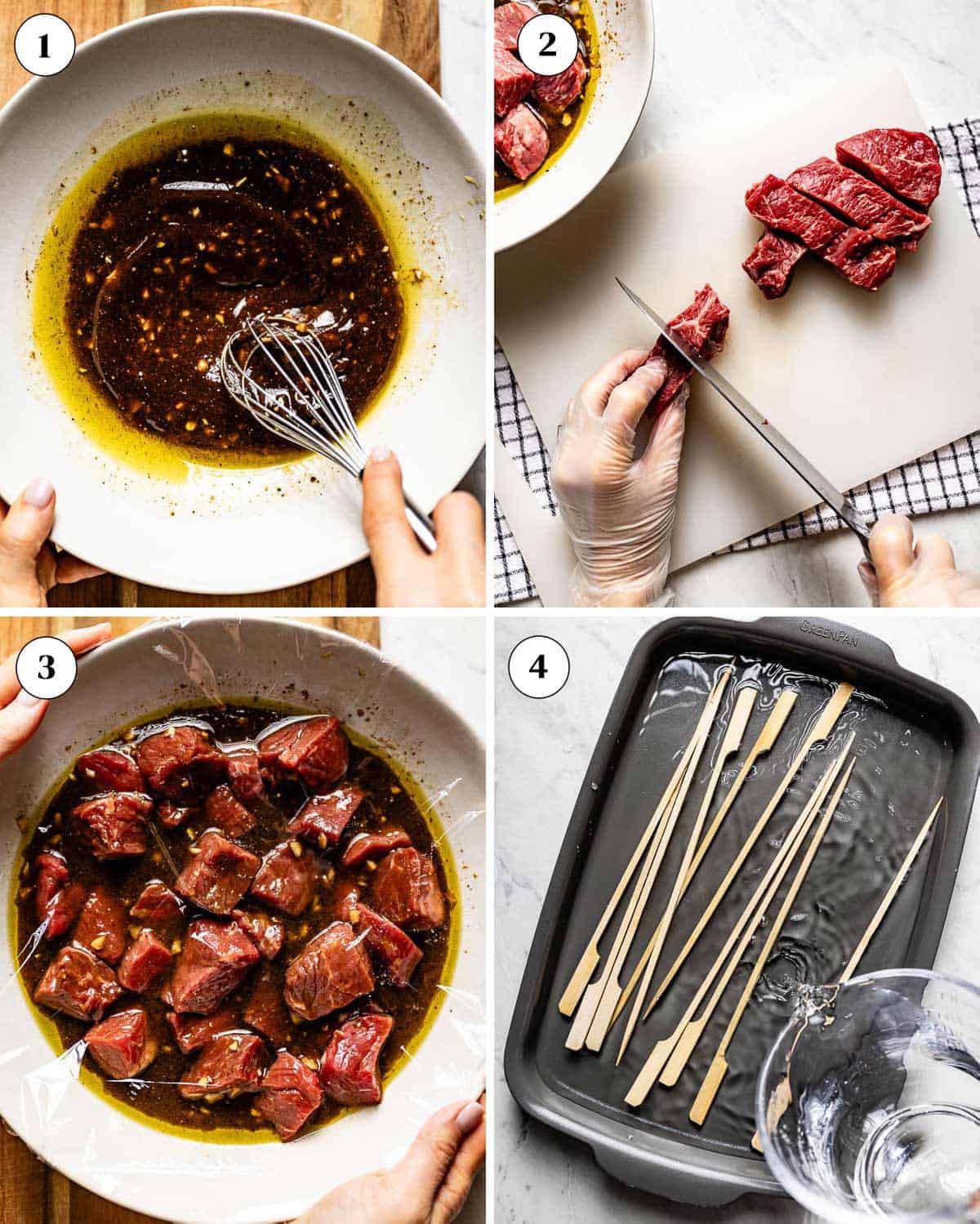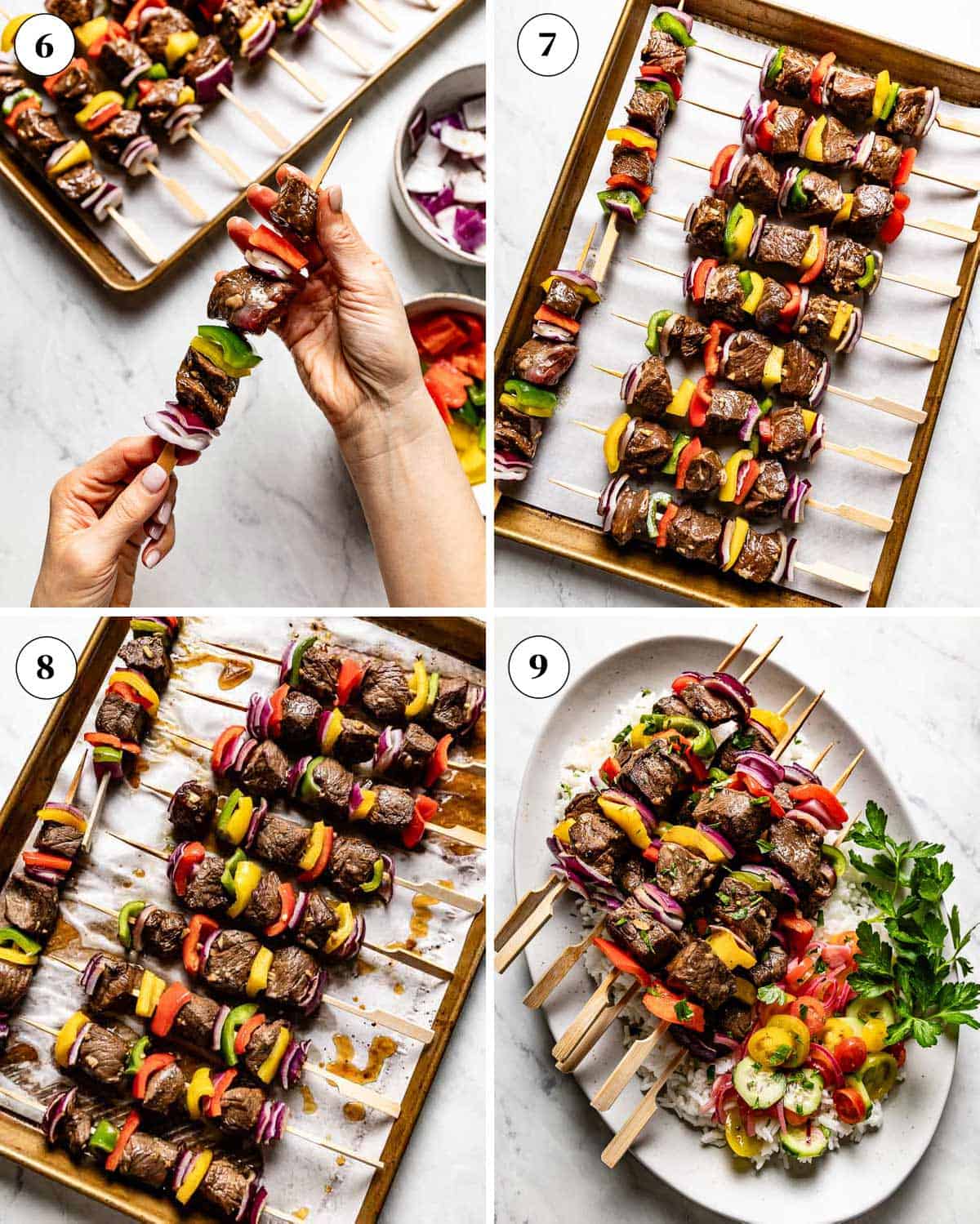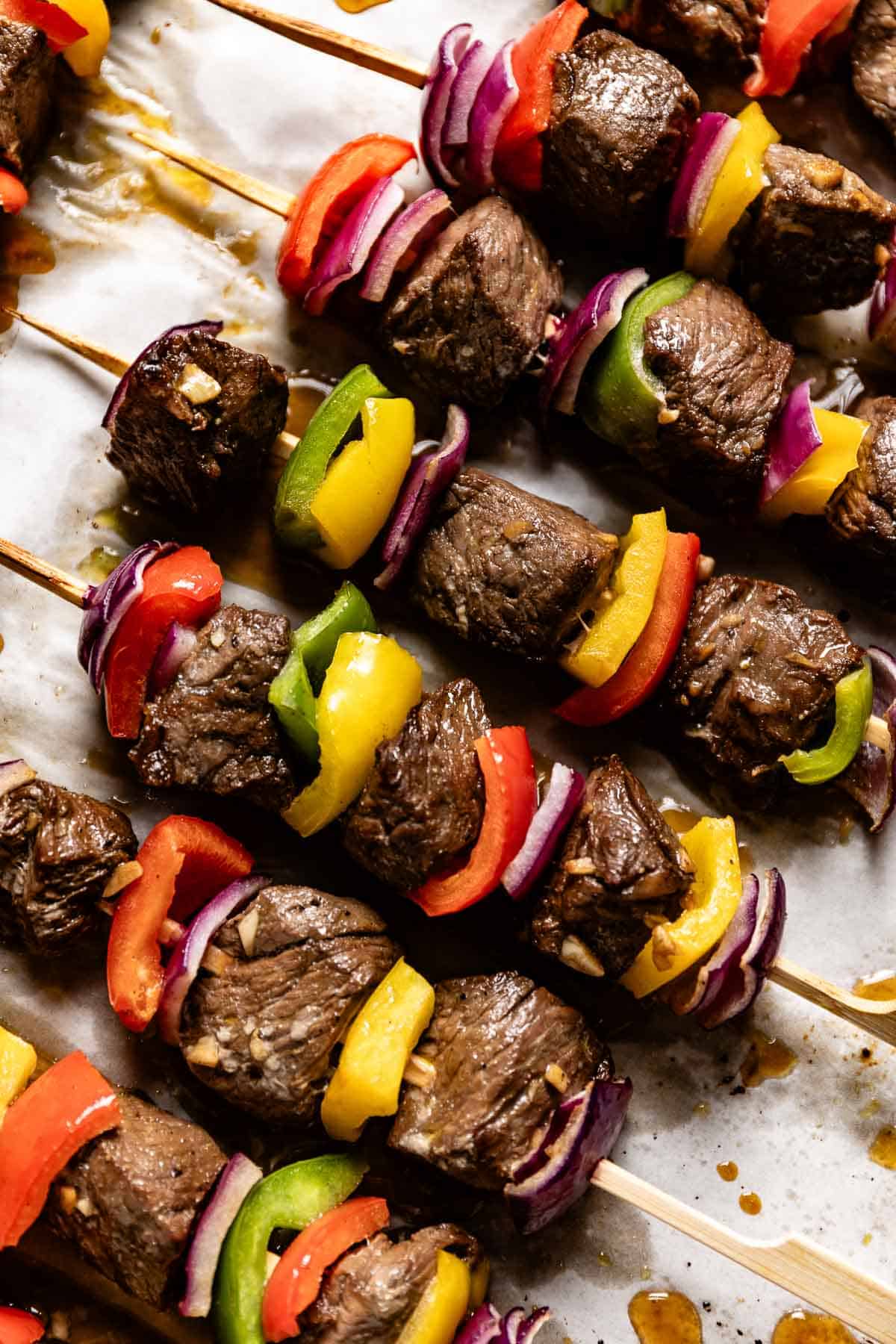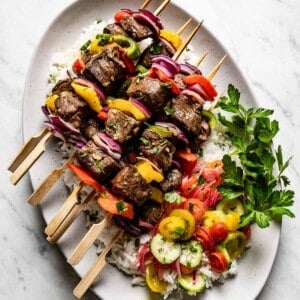If you are a fan of kabobs, also check out our Grilled Shrimp Kabobs.
Beef
If you’re wondering, “What kind of beef is best for kabobs?” I’ve got you covered! I’ve found the best cuts to make your easy steak kabobs as tender and flavorful as possible.
Sirloin: Sirloin is my favorite choice when making beef kebabs in the oven due to its flavorful composition. This inexpensive cut is widely available at most grocery stores. We tested this recipe both with top sirloin steak and sirloin roast. They both worked beautifully, so you can use either cut you can get your hands on. Tenderloin: Also referred to as “filet mignon,” beef tenderloin boasts one of the most tender textures among steaks. However, it tends to be more expensive than sirloin, so keep your budget in mind when selecting your type of kabob meat. Ribeye: The thorough marbling and heartiness of ribeye steak make it a no-brainer for those who value richness in their beef. However—similar to tenderloin—ribeye tends to be pricier than other steaks, so I prefer more cost-effective variations for this recipe. Chuck roast: Though this cut will technically work in this recipe, I don’t recommend it. Chuck roast tends to produce chewier and tougher meat—even given its long marination time—which will interfere with this recipe’s desired texture.
If preferred, you can use an alternate steak kabob marinade to achieve your desired flavor profile. However, just be sure to choose a marinade that will help break down the meat’s fibers to enhance the tenderizing process. Below are the ingredients for our favorite marinade for this recipe:
Olive oil: We used olive oil, but any other vegetable oil, like avocado oil, would work in this recipe. Soy sauce: Salty, bright, and full of umami flavor, soy sauce is one of the primary ingredients in my seasoning recipe. You may also substitute this ingredient with coconut aminos if you follow a gluten-free diet. Balsamic vinegar: Balsamic vinegar is a must in this recipe, as its acidic base best helps tenderize the steak and lends the meat complexly sweet undertones. However, lemon juice would also work in a pinch. Worcestershire sauce: Adding Worcestershire sauce to this steak marinade is my favorite way to lend it tangy, savory-sweet flavors. However, you may omit this ingredient if you prefer a gluten-free recipe. Dijon mustard Honey: A spoonful of honey is just what this recipe needs to balance its sharper flavors with a finger-licking sweetness. You may also use a tablespoon of brown sugar as an alternative to honey. Fresh cloves of garlic: Garlic is an excellent ingredient to add pungent, buttery notes to your steak seasoning. Though you can technically use garlic powder, I recommend fresh garlic, as it better infuses its flavors into the marinade. Kosher salt and black pepper
When selecting which veggies to use, choose those that cook quickly to avoid raw or undercooked pieces. For a better picture of what I mean, below are my favorite vegetables to add to oven kebabs:
Bell peppers: Bell peppers are one of my go-to’s when I want to give my beef skewers a garden-fresh bite. Any color of bell pepper would work in this recipe, from crisp green to sweet red. Red onions: Mildly sweet and oh-so-colorful, red onions expertly bring out steaks’ more robust flavors. Just be sure to separate the onion into layers before threading your skewers to avoid overly thick, undercooked slices. Mushrooms: Mushrooms are the perfect addition for anyone who can’t get enough umami-rich flavors. I usually opt for baby Bella mushrooms in this recipe due to their deep, earthy taste and firm texture. Cherry tomatoes: Want to brighten your easy beef kabobs with robust tomatoey flavors? Adding cherry tomatoes to your oven shish kabobs will give each bite a light, juicy finish.
Store: After cooking shish kabobs in the oven, let them come to room temperature. Then, transfer them to a sealed container and store them in the refrigerator for up to three days. Freeze: Beef does well when frozen. However, veggies tend to become soggy when exposed to low temperatures, so I recommend removing them from your beef skewers before freezing. Then, you may freeze your beef in an airtight container until ready to thaw. Thaw: You can thaw your steak kebaps by placing them in the fridge overnight. Then, heat and serve the beef when ready to eat. Reheat: I recommend reheating your shish kabobs in a low-heat oven (300 degrees F.) for 5-10 minutes or until heated through.
Grains: Want to transform your oven-baked steak kabobs into a filling menu? This meaty base tastes delicious with a side of basic rice pilaf, Wild Rice, or Brown Jasmine Rice. Or, if you want a more herbaceous, zestier option, my Herbed Quinoa and Tabbouleh recipes will easily convince your guests that you’re a professional chef. Salad: Nutritious, crisp, and delicious, green salads are just the perfect side dish to lighten this beefy main. If you want to pack your table with a colorful, superfood-packed side, I highly recommend serving your steak kabobs alongside a tangy Butter Lettuce Salad or zesty Kale Brussel Sprout Salad. Or, if you’re in the mood for gourmet Italian classics, my cheesy Caprese with Burrata and savory La Scala Salad will give your menu a five-star finish. Sauces: If you love the complex taste of savory meats dipped in flavor-packed sauces, these recipes are just what you need. I love pairing oven-baked shish kabobs with a creamy Yogurt-based sauce, such as my cool Mediterranean Tzatziki. Otherwise, my zesty Pesto Dressing will enliven every bite with a fresh, herby taste.
Cutting beef: When cutting your steak into cubes, try to cut them into equal bite size pieces. Doing so will ensure each piece cooks at an even rate, thereby avoiding over- or undercooked meat. Poke the meat: If you want to infuse every bite of meat with a sumptuous flavor, I highly recommend poking or gently piercing the steak (from a few places) with a fork before beginning the marination process. These perforations will help the marinade infuse your meat’s fibers more deeply, ensuring the center is as well-seasoned as the exterior. Don’t skip on the marinade: Marination is vital to ensure your beef tenderizes and has a complete infusion of flavor. I recommend marinating steak for a minimum of six hours or up to twelve hours for best results. Soak wood skewers: If you’re using wooden or bamboo skewers, be sure to soak them in water for a minimum of thirty minutes before assembly. Soaking skewers in water will keep the wood from scorching when exposed to high heat. Thread them lightly: You mustn’t thread your kebabs too tightly when assembling them. Looser threading will ensure every component of the kabob—whether meat or vegetable—has the same amount of surface area exposed to the oven’s heat, thereby allowing for even cooking. Temperature of the oven: Though we tried cooking these beef kabobs at 450 and 400 degrees F., we found that these high temperatures tended to cook the meat and veggies unevenly, leading to undercooked vegetables and overcooked meat. In the end, we decided that a milder, 375 degrees F. oven followed by a quick broil worked best to mimic the flavors of grilled beef kabobs. Check for doneness: The best way to check the doneness of your steak shish kabobs is by inserting a meat thermometer into the center of a piece of beef. If you want your meat to be medium (which I prefer in this recipe), aim for an internal temperature of 140-145 degrees F., or 63 degrees C. If you want your beef to be medium-rare instead, the internal temperature of the steak should reach 130-135 degrees F. (57 degrees C.). No matter what level of doneness you prefer, however, try to avoid overcooking the meat to maintain its delicious flavor and tender texture. Let the meat rest: For the juiciest, most flavorful meat, it’s essential to let your steak rest for a minimum of five minutes after cooking. This resting time ensures the steak’s juices don’t spill out after the first cut and give you dry, flavorless meat. Instead, the juices will have time to redistribute evenly throughout each piece, giving every bite a rich, juicy flavor.
If you try this Beef Kabobs in Oven recipe or any other recipe on Foolproof Living, please take a minute to rate the recipe and leave a comment below. It is a great help to others who are thinking of making the recipe. And if you took some pictures, be sure to share them on Instagram using #foolproofeats so I can share them on my stories.

